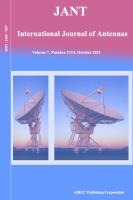THE EFFECTS OF CONDUCTIVITY OF THE MATERIALS ASSOCIATED WITH THE WEDGES ON THE LOSS BY DIFFRACTION
International Journal of Antennas (JANT), 1 (1):
15 (Oktober 2015)DOI: 10.5121/jant.2015.1101
Zusammenfassung
Radio wave signals do not travel in a straight line path. There may be some obstacles between the source and the destination which cause diffraction, reflection, scattering and attenuation. There are some types of obstacles such as knife edge, wedges and round edges. This paper shows the diffraction loss caused by
wedges based on Uniformal Theory of Diffraction (UTD) given in (ITU-R Recommendation P.526-12) using Matlab software. It could be said that this is an important method because radio waves travel over wedge shaped roofs of buildings and corners of the buildings. In addition this diffraction loss changes for both roofs and corners for a particular obstruction material. Furthermore, the electrical properties of the wedge shaped obstacles are affecting the diffraction loss such as conductivity and dielectric constant. The result shows that higher conductivity leads to have a higher amplitude oscillation at the receiver.
Links und Ressourcen
Tags
Community
@habibullas Tags hervorgehoben

